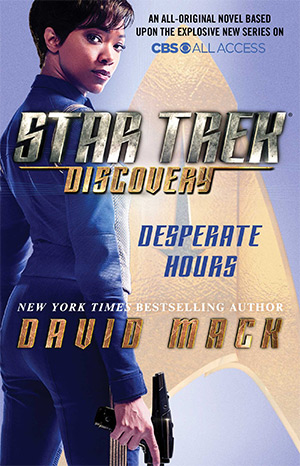The excitement of Sunday’s premiere of Star Trek: Discovery was quickly followed by Tuesday’s release of Star Trek Discovery — Desperate Hours, the first tie-in novel featuring the crew of the USS Shenzhou authored by veteran Star Trek scribe David Mack.
(If you missed it, check out our review of the recent release!)
We were fortunate to get the opportunity to talk to David about the book, how it came to be, and the challenges associated with writing the first novel featuring a cast and crew who hadn’t been seen on the screen at the time of writing.
Our interview contains minor spoilers for the plot of Desperate Hours, including the supporting role of the Christopher Pike-era USS Enterprise and Mack’s integration of the Original Series and Discovery visual aesthetic.
* * *
TREKCORE: I understand that Bryan Fuller had the initial concept idea for this story, and that you worked closely with the Star Trek: Discovery writers’ room on its execution.
Can you describe what that experience was like, and was that more challenging than the normal process for writing Star Trek novels?
DAVID MACK: Bryan Fuller’s request, which was relayed to me by Discovery staff writer and media tie-in coordinator Kirsten Beyer, was simply that he wanted to see a story that crossed over the crew of the USS Shenzhou with that of Captain Pike’s famed Starship Enterprise. How I accomplished that, and to what effect, was left to my discretion.
There were some false starts before we reached that stage, however. Much earlier, when the show’s concept was still being debated by its top producers, there had been some suggestions that the first novel might be a story from Michael Burnham’s childhood or her adolescence (at the time it was not yet clear how old she would be in the series, or when exactly the series would be set).
I had actually gotten relatively far along on a couple of those iterations before the creative direction behind the scenes changed, and I was asked to start over with the Shenzhou–Enterprise story as my new springboard.
The notes I received from Kirsten and the writers’ room on the outline were minimal. I made a few changes and cut a few details that were considered too spoilery for some of the characters. But aside from those minor adjustments, the story was approved quite easily.
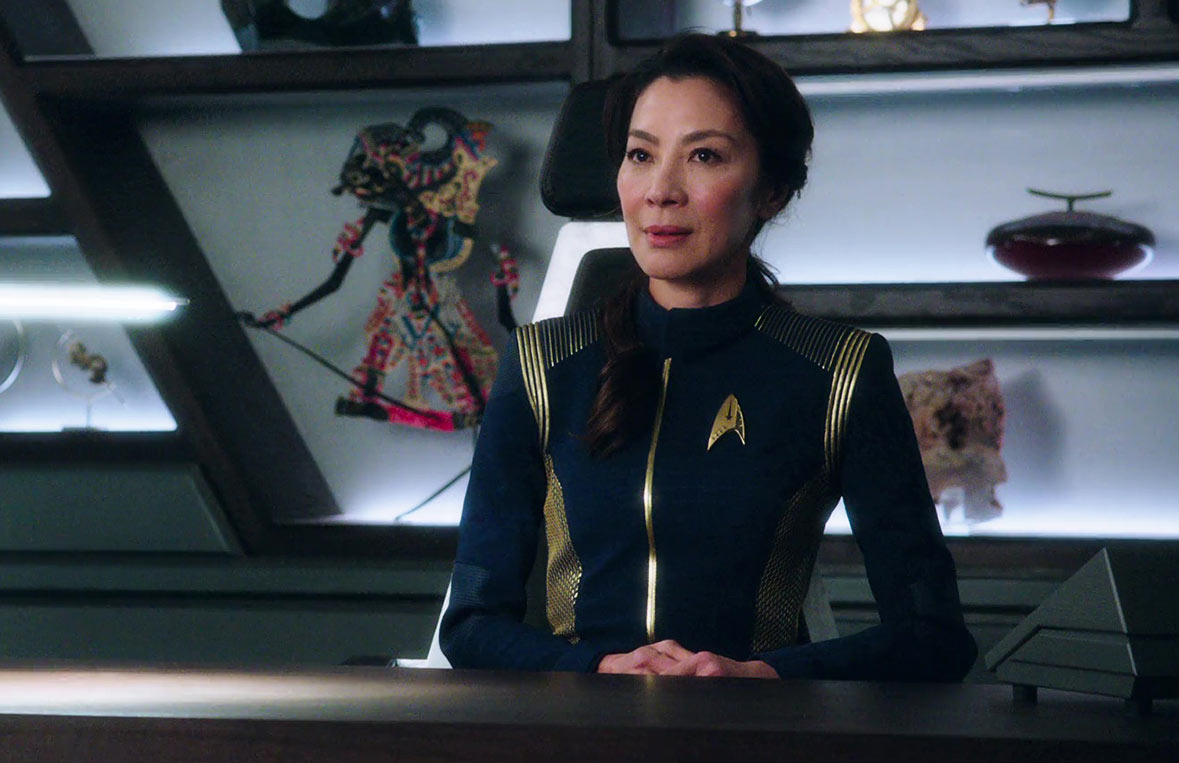
It was during the execution of the manuscript that I grappled with the two biggest challenges of writing a tie-in novel based on a series that hasn’t been filmed yet. First, all I had to guide me with regard to the characters’ voices were the scripts. I was deep into the novel when the show started filming and I finally got to see photos of the cast in costume and makeup. Before that, all I’d had to work from were set photos, design sketches, concept art, and prop designs.
The other hurdle was that I frequently had to stop writing and go back to revise earlier scenes and often also the outline of my novel whenever the writers’ room changed their mind about some detail or other. I had to pay very close attention to every update of revised script pages, because a tiny change of wording in a single line of dialogue could make the difference between my scenes tracking with the show’s continuity or winding up way off.
The biggest risk of all? My novel was locked sometime around June, after final edits. At that point, there was still half a season of the series left to be written. Which means any continuity errors between my book and the show — after episode 108 — are not my fault. Just sayin’.
TREKCORE: Which of the new Discovery characters were the most fun to write?
MACK: Saru quickly became my favorite Discovery character to write. There is such a great deal of complexity to him. Though the series’ premiere makes Saru seem very binary in his outlook, he is a being of subtleties and contradictions.
When I delved into his history and the professional rivalry between him and Michael Burnham, I found myself sympathizing with Saru much more than I’d expected to. His story arc in Desperate Hours focuses on his need to accept and make his peace with the fact that he has been passed over for promotion, and now finds himself placed in a role subordinate to Michael, who he thinks does not deserve to be the Shenzhou’s first officer.
But there is more to Saru than fear and resentment. He has hope, curiosity, and compassion. He also has a great deal of love and admiration for his shipmates—but he is plagued by a social awkwardness that makes it difficult for him to convey his feelings to those around him. He is a wise and gentle soul who is all too often misunderstood by his peers.

TREKCORE: Sticking with Saru, he has a strong supporting character role in the book, but there isn’t any previous backstory or reference material to draw from for him other than what we see in Discovery because the Kelpians are a new race.
How did you overcome the challenge of aligning your depiction of the character with what we see on screen?
MACK: Having concept art carried me through the early phases. But it wasn’t until after the two-part pilot script was close to locked that his personality and “voice” took shape.
One of my colleagues, a fellow Star Trek author, did a lot of work fleshing out the backstory and world-building related to the Kelpiens. My work was built while standing upon his shoulders.
Though most of that information about the Kelpiens is not yet canon, and some of our assumptions are likely to be superseded by future canon, we were able to get enough of it approved that we could arrive at a consistent characterization of Saru based on his species, personal history, and known quirks of temperament.
Later, during the editing phase on Desperate Hours, at which point we had a few more scripts from which to work, I tweaked some of Saru’s dialogue and exposition to make certain it tracked with facts established after I’d finished my submission draft.
That’s the really hard part of writing a tie-in for a show that hasn’t aired yet: revisions are like trying to repair a jet engine… while the aircraft it’s driving is cruising at forty thousand feet.
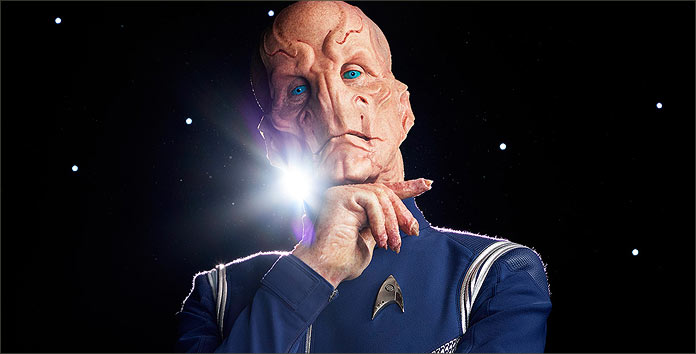
TREKCORE: The book includes a number of characters from the crew of the USS Shenzhou who did not have big roles on screen. How much of those characters’ back stories were the creation of the writers’ room, and how much did you have to invent?
MACK: When I started working on the story for Desperate Hours, I realized that in the early script drafts of the pilot almost none of the Shenzhou’s bridge crew had names. They were just “conn officer,” “engineering officer,” “tactical officer,” etc. In the action scenes, Captain Georgiou never addressed her crew by names, just by their job titles.
I quickly realized that was absolutely not going to work in a novel. In filmed entertainment, which has an external point of view, one can get away with glossing over such details. (Though, in my opinion, it makes characters feel less “real.”)
It’s possible the scripts were being left vague so that the identities could be tailored after casting to fit the actors hired to those roles. But I didn’t have the luxury of waiting for that to happen; I had to start writing my book.
I was allowed to compile information about the minor characters, new aliens, and the principal starships into a pseudo-bible for the series. Where there were gaps, I was given latitude to fill them in. Consequently, I got to name half the bridge crew of the Shenzhou, including Keyla Detmer, Troy Jannuzzi, and Kamran Gant.
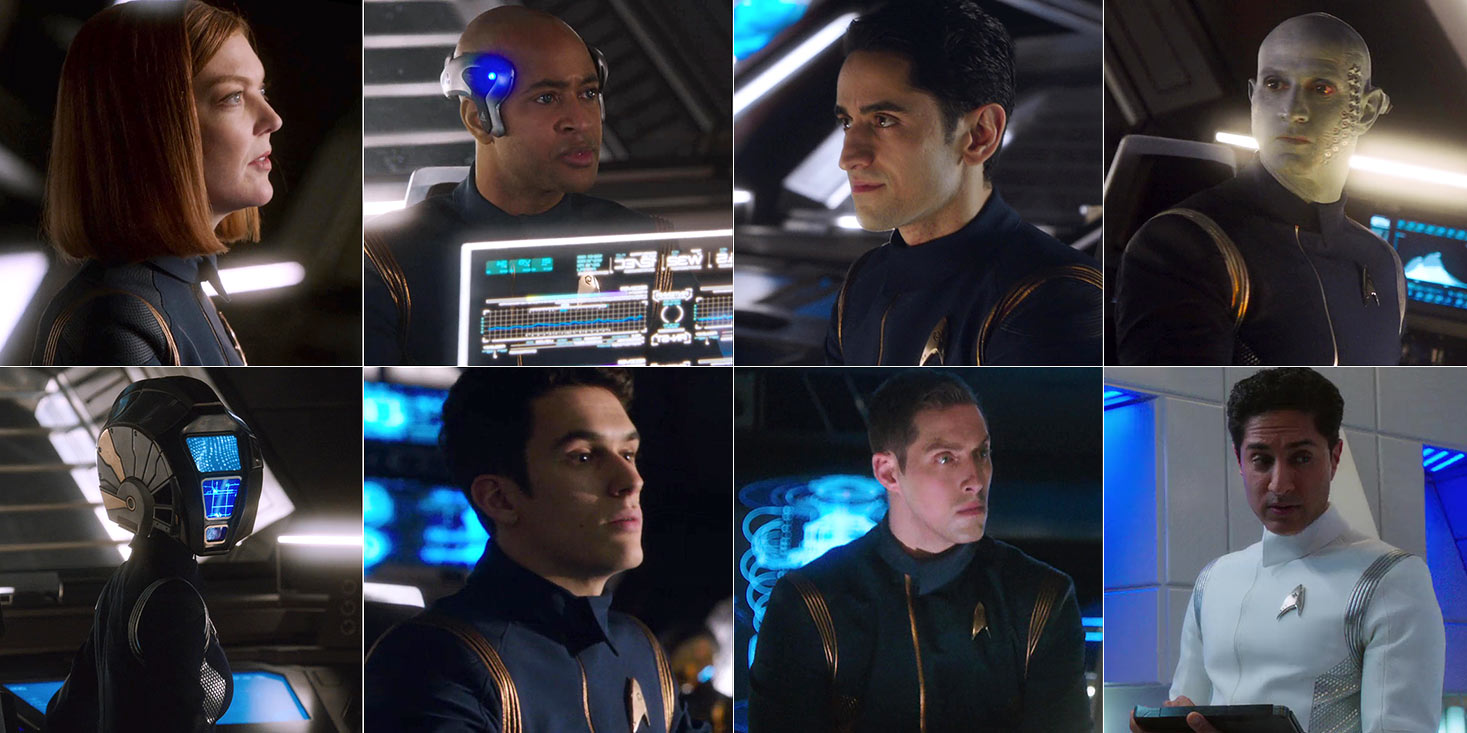
Some of the characters never named in the pilot include Ensign Proat (the bald blue guy with plugs in his head) and Lieutenant Jira Narwani (the girl in the Daft Punk video helmet). I wrote full bios and profiles for all of these characters, as well as for Ensign Danby Connor (ops), Ensign Britch Weeton (engineering), and Doctor Anton Nambue, and also expanded bios for Georgiou, Burnham, and Saru.
I also got to place on the bridge of the Shenzhou some original characters who are, for whatever reason, no longer there a year later when the series premieres. Those include communications officer Ensign Mary Fan and operations officer Lieutenant Belin Oliveira. I also gave the Shenzhou a chief engineer, Lieutenant Commander Saladin Johar.
Fun detail: some of those bios ended up being shared by the show’s producers with the actors playing those supporting roles, to provide them with a foundation for their performances.
TREKCORE: In addition to the new crew of the USS Shenzhou, the story features a significant role for the USS Enterprise under the command of Captain Christopher Pike.
What was it like to put the Enterprise opposite the Shenzhou, and how did you balance integrating a ship and characters whose last appearance was in The Original Series, versus the new crew and the updated visual style of Star Trek: Discovery?
MACK: Once I began in earnest to develop the story that Bryan Fuller had asked for, I struggled at first to think of a situation that would be so dire as to merit the involvement of two Starfleet vessels, especially when one of them was the Enterprise.
I didn’t want to let the Enterprise and its crew overshadow the book’s main cast on the Shenzhou. I shared this conundrum with fellow author John Jackson Miller, and he gave me some good advice. “Pit the two crews against each other,” he said, “and have them both be right.” Once I did that, the shape of the story revealed itself, and it came together very naturally.
The chief concern I had in placing the crews and ships side-by-side in my narrative was that I knew it would invite questions and comparisons. In particular, folks would ask why the technology of an older ship looks more advanced than that of a newer ship. And why did the crews wear different uniforms? I didn’t want to offend fans of the new show or fans of the Original Series, so I knew I couldn’t just pretend that the Enterprise looked like the Shenzhou, or that its crew wore the same uniforms as the ones we see in Discovery.
I addressed the difference in the ships’ aesthetics to a human tendency to want to redesign even the simplest things every few years, whether we need to or not. This confuses Earth’s closest allies, the Vulcans and the Andorians, who can’t understand why humans don’t just pick a style and stick with it. But that’s just the way humans are — always changing fashions, styles, etc.
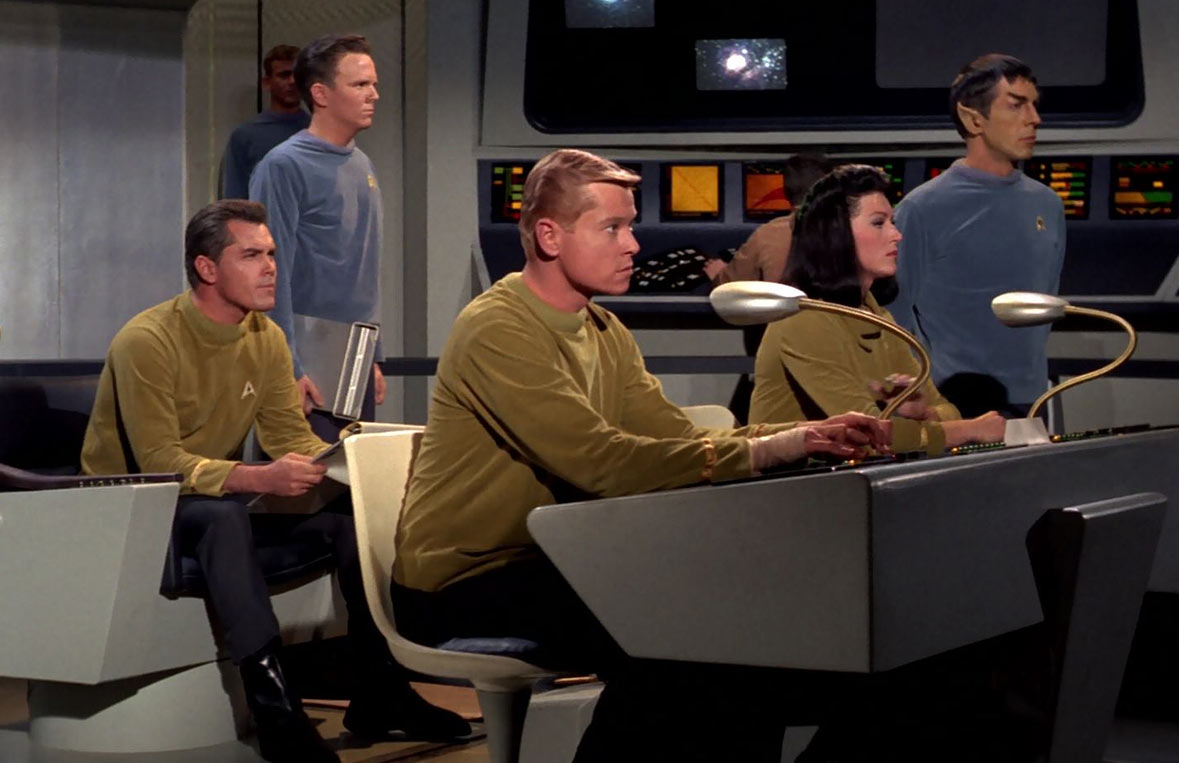
The differences in technology posed a different hurdle. I posited that the use of subspace holograms had fallen out of favor by the time the Enterprise was built because the holograms were bandwidth hogs on subspace channels and prone to encryption flaws. And while the interfaces on the Shenzhou’s bridge look fancier, the characters who serve on the Enterprise feel proud that their ship is so advanced that it doesn’t need all these gadgets to get the job done.
I have a moment near the end of the book when the Shenzhou lands what the crew thinks is a solid hit on the enemy — and then they watch a phaser beam from the Enterprise’s state-of-the-art weapons carve off part of the enemy’s hull. And the Shenzhou crew is just flabbergasted and in awe. In that moment we see their respect and reverence for the majesty of a Constitution-class starship.
As far as the differences in the crews’ uniforms, there is ample precedent in real life for a military service having multiple approved duty uniforms at any given time, and sometimes special uniforms for elite units, etc. So my retcon for the difference in the uniforms is that most of Starfleet is wearing the “utility blue” jumpsuits of the Shenzhou crew.
But the crews of the Enterprise and other Constitution-class ships are considered elite units, so they’ve been issued special “diplomatic” uniforms to designate their status. What I like about my solution is that it explains the apparent discrepancy while showing proper reverence for the Original Series.
TREKCORE: For the better part of a year you’ve known the story behind Star Trek: Discovery and had to keep quiet. Now that the world has had the chance to see the first two episodes, what aspects of those episodes did you enjoy most?
Were there elements from those first two episodes that you thought were particularly ripe for greater exploration in Desperate Hours?
MACK: I loved the interactions between Burnham and Saru, and between Georgiou and Burnham.
The bonds between those three characters, and the dynamic of two children competing for a parent’s attention and approval, struck me as something new in the Star Trek canon, and as fertile ground in which to seed new stories (even if they need to be told in flashbacks).
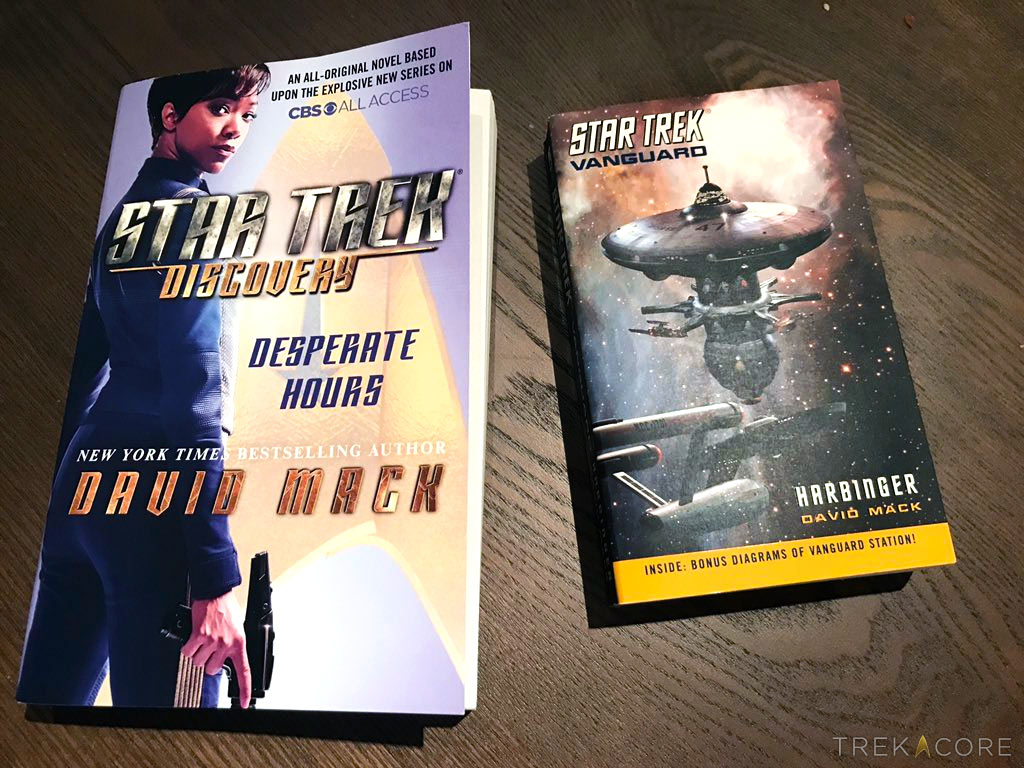
TREKCORE: For those people who are reading your work for the first time because of Star Trek: Discovery and want more, what other books you’ve written would you recommend they pick up, and what can we look forward to from you in the near future?
MACK: Fans of 24th-century Star Trek — that’s The Next Generation, Deep Space Nine, and Voyager — would probably enjoy my two trilogies, Star Trek: Destiny and Star Trek: The Next Generation – Cold Equations.
Fans of the Original Series would likely get a kick out of the Star Trek: Vanguard saga, an eight-book series I developed with editor Marco Palmieri and on which I alternated writing duties with the writing duo of Dayton Ward & Kevin Dilmore.
Next up for me is a Star Trek: Titan novel, Fortune of War, coming out on Tuesday, November 28. It’s a follow-up to a third-season TNG episode, “The Survivors,” in which a godlike being exterminated a race known as the Husnock. But he left behind all of their terrifying ships and weaponry and technology — which now is being found by unscrupulous bad guys. It falls to our heroes on the USS Titan to keep the Husnock’s deadly toys out of the wrong hands.
My biggest book news, however, is the publication of The Midnight Front, the first volume in my original Dark Arts series from Tor Books. The Midnight Front is a World War II adventure that combines brutal action with demon-based black magick and a tale of revenge.
It’s coming out on January 30, 2018, and will soon be followed by The Iron Codex (a spy thriller with magick set in 1954 during the Cold War) and The Shadow Commission (a conspiracy thriller set in 1963, right after the Kennedy assassination).
Dark Arts is my passion project, years in the making, and I hope that all of the readers who have enjoyed my Star Trek stories through the years will follow me as I embark on this new narrative journey.
![]()
Thanks to David for taking the time to chat about his new book. If you enjoyed Sunday night’s premiere, we recommend picking up a copy of Star Trek: Discovery — Desperate Hours and get to know more about the Shenzhou crew!
For more information about David and his upcoming work, visit David Mack at his official website, find him on Facebook, or follow him on Twitter.

